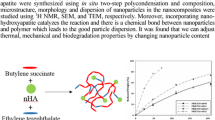Abstract
A previously developed method to improve the interface between hydroxyapatite (HA) and a polyester-ether (PolyactiveTM 70/30) by using polyacrylic acid or poly(ethylene-co-maleic acid) has been applied to HA/PolyactiveTM 30/70 composites noting that polyactiveTM 30/70 contains less polyethylene glycol (PEG) segments and a higher concentration of rigid poly(butylene terephthalate) (PBT) segments. The mobility of the PEG segments is significantly affected by the existence of a high concentration of rigid PBT segments. Our experimental results show that this method is indeed suitable for making HA/PolyactiveTM 30/70 composites. The hydrogen bond/dipole interaction forming ability of the PEG segment is not affected by the existence of relatively large amounts of PBT segments. By using these coupling agents, the mechanical properties of the composite can be significantly improved both in dry and wet states. A fractographical study of the fracture surfaces revealed that the surface modified HA particles maintain better contact at fracture. It also showed that larger HA particles may initiate cracks and that such particles may be responsible for a decrease in the tensile strength of the composites.
Similar content being viewed by others
References
W. Bonfield, in “Materials characteristics versus in vivo behaviour”, edited by P. Ducheyne and J. E. Lemons (New York Academy of Science, New York, 1988) p. 173.
K. E. Tanner, C. Doyle and W. Bonfield, in “Clinic implant materials: advances in biomaterials”, edited by G. Heimke, U. Soltesz and A. J. C. Lee, Vol. 9 (Elsevier, Amsterdam, 1990) p. 149.
C. C. P. M. Verheyen, J. R. de Wijn, C. A. van Blitterswijk, P. M. Rozing and K. de Groot, in “Bonebonding biomaterials”, edited by P. Ducheyne, T. Kokubo and C. A. van Blitterswijk (Reed Healthcare Communications, Leiderdorp, The Netherlands, 1992) pp. 153–171.
M. Wang, D. Porter and W. Bonfield, Brit. Ceram. Trans. 93 (1994) 91.
C. A. van Blitterswijk, D. Bakker, H. Leenders, J. V. D. Brink, S. C. Hesseling, Y. P. Bovell, A. M. Radder, R. J. Sakker, M. L. Gallard, P. H. Heinze and G. J. Beumer, in “Bone-bonding biomaterials”, edited by P. Ducheyne, T. Kokubo and C. A. van Blitterswijk (Reed Healthcare Communications, Leiderdorp, The Netherlands, 1992) pp. 153–171.
D. Bakker, J. J. Grote, C. M. F. Vrouenraets, S. C. Hesseling, J. R. de Wijn, C. A. van Blitterswijk, in “Clinical implant materials”, edited by G. Heimke, U. Stoltese and A. J. L. Lee (Elsevier, Amsterdam, 1990) p. 99.
C. A. van Blitterswijk, J. V. D. Brink, H. Leenders and D. Bakker, Cells and Mater. 3 (1993) 23.
A. M. Radder, J. E. Davies, H. Leenders and C. A. van Blitterswijk, J. Biomed. Mater. Res. 28 (1994) 269.
Q. Liu, J. R. de Wijn, D. Bakker and C. A. van Blitterswijk, J. Mater. Sci. Mater. Med. 7 (1996) 551.
J. C. Skinner, H. J. Prosser, R. P. Scott and A. D. Wilson, Biomaterials 7 (1986) 438.
D. Belton and S. I. Stupp, Macromolecules 16 (1983) 1143.
J. Ellis, A. M. Jackson, R. P. Scott and A. D. Wilson, Biomaterials 11 (1990) 379.
D. N. Misra, Langmuir 7 (1991) 2422.
K. L. Smith, A. E. Winslow and D. E. Peterson, Ind. Engng. Chem. 51 (1959) 1361.
Y. Osada, J. Polym. Sci. Polym. Chem. Edn. 17 (1979) 3485.
S. Fakirov and T. Gogeva, Makromol. Chem. 191 (1990) 603. ??
Author information
Authors and Affiliations
Rights and permissions
About this article
Cite this article
LIU, Q., de WIJN, J., BAKKER, D. et al. Polyacids as bonding agents in hydroxyapatite polyester-ether (PolyactiveTM 30/70) composites. Journal of Materials Science: Materials in Medicine 9, 23–30 (1998). https://doi.org/10.1023/A:1008826410395
Issue Date:
DOI: https://doi.org/10.1023/A:1008826410395




